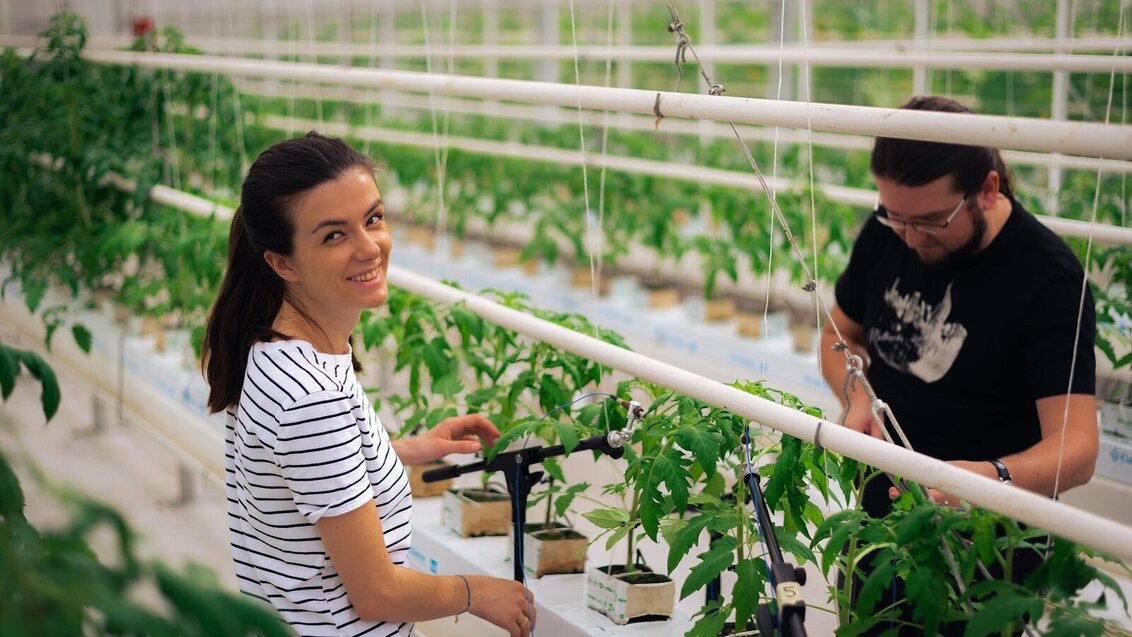
The stage of research performed in controlled conditions in the anechoic chamber of the Technical Acoustics Laboratory at the AGH University. Photograph: K. Chojnacka, B. Chojnacki
Together with employees from the Department of Horticulture at the Wrocław University of Environmental and Life Sciences, AGH University researchers examine whether plants emit sounds, inaudible to the human ear, indicative of stress in cases such as water shortage, excessive dryness, or attack of pests. To help the plant specialists with the task come the acousticians from the AGH University who are able to register sounds generated by plants with the use of specialist microphones sensitive to ultrasounds.
The cooperation with the experimental glasshouse at the Centre of Advanced Horticultural Production Technologies of the Wrocław University has led to research which may be taken advantage of in plant diagnostics. Information and conclusions from further experiments may serve as an indication for horticulturists on how to take better care of large-scale crops and react more quickly to changes in irrigation or pest control.
Dr Janusz Mazurek from the Department of Horticulture admitted that the research on sounds emitted by plants has a practical aspect to it:
“We consider such a type of research to be innovative, and obtained results may be helpful for example in the research on stress in plants caused by physiological factors like water shortage, excessive temperature, deficiencies of nutrients, as well as those caused by diseases and pests. In horticultural production, recognising what is the problem quickly and in a non-invasive manner determines the effectiveness of actions undertaken by producers. This fits in with the broadly understood actions related to integrated production."
Plants generate sounds of frequencies which are inaudible to the human ear. The emitted ultrasounds may be registered solely by specialist microphones used by the researchers who work on a daily basis in the Technical Acoustics Laboratory in the Department of Mechanics and Vibroacoustics of the AGH University Faculty of Mechanical Engineering and Robotics.
Monitoring tomatoes in greenhouses
“The initial stage of our research was performed in experimental glasshouses of the Centre of Advanced Horticultural Production Technologies, where we studied small tomato seedlings which grow quite fast under the right conditions. It was crucial for the conditions for plant cultivation to be the best they possibly could be, and only competent staff could provide such, people who work in experimental glasshouses on a daily basis and know how to create such conditions. Each week, the increase in the height of tomatoes reached up to 30 cm according to our measurements,” Klara Chojnacka, AGH University doctoral student, explained.
The part of research performed in glasshouses in Wrocław. Photograph: Piotr Książek

The measurement results can be of help in plant stress research. Photograph: Piotr Książek

 AGH University Alumni Day 2024
AGH University Alumni Day 2024  20 years of AGH University-SIT partnership and inauguration of Alumni Association in Tokio
20 years of AGH University-SIT partnership and inauguration of Alumni Association in Tokio  Projects by AGH University Main Library with funding from Scientific Social Responsibility programme
Projects by AGH University Main Library with funding from Scientific Social Responsibility programme  Honouring those we lost this year
Honouring those we lost this year  On energy transformation and more. Distributed Energy Congress
On energy transformation and more. Distributed Energy Congress  AGH University to establish AI Factory
AGH University to establish AI Factory 

